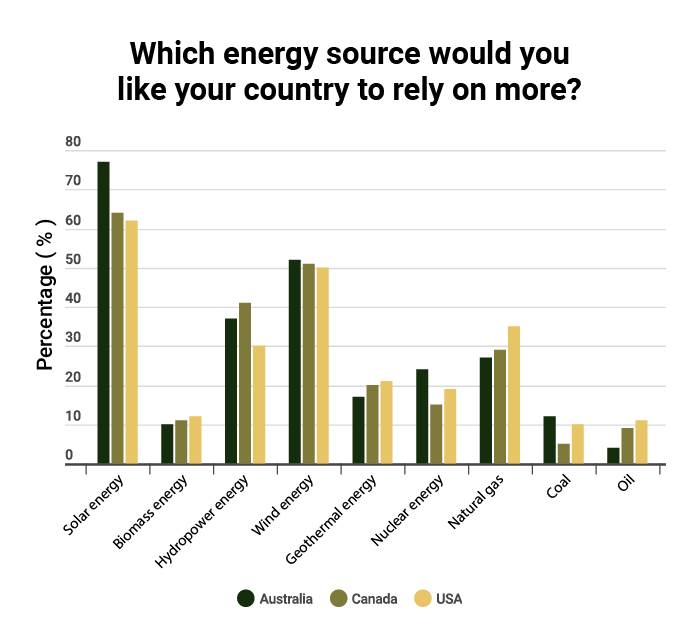The Burrow

To help fight climate change and increase diversity among energy generation, nations across the world are investing in renewable energy.
With the onset of 2022 also came an energy crisis, which saw prices of natural gas and coal increase worldwide. Heightened cost of living expenses has ignited further conversation about the need for a diverse supply and home-grown generation.
For example, on 28 September 2022 the Premier of Queensland in Australia announced a plan to build the biggest hydroelectricity scheme in the world with two new pumped hydro dams to be operational by 2035.1 The Australian Federal Government introduced the Climate Change Bill 2022, which will reduce emissions to net zero before 2050 by investing heavily in renewable energy.2
It’s a similar story in North America. Canada’s plan for net-zero by 2050 relies on clean electricity and other types of clean fuel such biofuels and hydrogen, which Canada is investing in heavily to meet their energy and climate goals.3 In January 2022, the President of the United States announced a plan to invest in wind, solar and other clean energy projects, with America’s plan focusing on offshore wind power.4
It’s very apparent that energy is a critical topic of discussion these days given climate change and the energy crisis, so we decided to see how people’s bills have changed in recent times and to gauge their sentiment on the types of energy used.

Based on the answers of survey respondents when asked about their last quarterly electricity and gas bills, Americans pay the most for both electricity and gas on average. Typically, Americans pay US$97 (AU$149) more than Canadians and US$133 (AU$205) more than Australians for electricity.
The difference between the average American gas bill and that of their northern neighbour is much less pronounced, with only a US$16 (AU$25) difference between Americans and Canadian gas bills, while Australians pay US$85 (AU$131) less than Americans for gas.
| Nation | Average electricity bill last quarter (US$) | Average gas bill last quarter (US$) |
| Australia | $247 | $171 |
| Canada | $282 | $240 |
| USA | $379 | $256 |
At least half the people surveyed in each country had noticed their electricity bills increase in the last six months. Americans were the most likely to have a bill increase in the six months before September 2022, with 63% of respondents saying they had noticed their electricity bills had risen. Australians were second-most likely with 59% of respondents being stung with an increase recently, meanwhile Canadians were least likely, despite 55% saying their bills had gone up.
For the majority, bills rose less than $100 in each nation’s local currency, as shown in the table below.
| Increase in electricity bill | Australia | Canada | USA |
| $1-$100 | 71% | 76% | 73% |
| $101-$200 | 19% | 13% | 16% |
| $201-$300 | 6% | 4% | 4% |
| $300+ | 4% | 7% | 7% |
| Average increase amount ($USD) | $74 | $112 | $140 |
It’s a similar story with gas bills, with 53% of Canadian, 52% of Australian and 51% of American gas consumers noticing an increase in their bills in the six months preceding the survey. When it comes to how much gas bills were increasing, here’s the results.
| Increase in gas bill | Australia | Canada | USA |
| $1-$100 | 76% | 70% | 86% |
| $101-$200 | 14% | 11% | 6% |
| $201-$300 | 7% | 9% | 2% |
| $300+ | 3% | 10% | 6% |
| Average increase amount ($USD) | $60 | $101 | $104 |
With evident price hikes in energy and gas bills, people are tasking many different approaches to reduce them. Interestingly, Australians, Canadians and Americans all stated that their number one method for reducing electricity bills was minimising the use of lights.
The next most popular methods then vary for each country. In Australia, the second-most popular method was limiting the us (no small sacrifice for comfort during the Australian summer). In Canada and America, the second-most popular way to reduce electricity usage was to unplug devices or turn appliances off at the wall.
While Americans and Canadians both agreed that lowering the temperature on the thermostat was the most popular way to reduce gas bills, Australian respondents instead listed shorter showers as their number one method.
There are so many factors that influence the cost of electricity and gas bills, and recent events have had a particularly negative impact on many of them. For example, the price for manufacturing electricity and gas has increased considerably, and this means energy providers need to adjust their rates to help pay for higher wholesale costs.
Supply factors are another key element behind rising costs. Offshore gas exports and imports were heavily impacted by the COVID-19 pandemic, and conflicts in certain parts of the world have also impacted the pipelines and wires transporting power to different countries. This means the supply may not meet the demand, exacerbating energy costs.
Given these factors, it’s no wonder that survey respondents wanted their countries to rely more on different types of renewable energy that could be generated at home.
Another way to fight against rising energy bills is to compare electricity and gas plans to see if there is a better deal available to you in your area. Even a small difference in tariffs can save money over time, and you might find a plan with other perks or features that you like more.
Across all three countries, solar power was the most preferred energy source people wanted their country to rely on more, followed by wind energy and hydropower (except for the USA where natural gas was the third-most popular), with similar percentages of survey respondents selecting each source of power.

Brought to you by Compare the Market: Making it easier to compare energy plans in Australia.
Compare the Market commissioned Pure Profile to survey 1,003 Australians, 1,000 Canadians and 1,007 Americans in September 2022. Respondents answered the survey questions using their local currency. Prices were rounded to the nearest whole number and were converted into USD on 29/09/22.
1 World’s biggest pumped hydro for Queensland. Queensland Government. 2022.
2 Albanese Government Passes Climate Change Bill in the House of Representatives. Australian Government. 2022.
3 Clean fuels – fueling the future. Government of Canada. 2022.
4 FACT SHEET: Biden-Harris Administration Races to Deploy Clean Energy that Creates Jobs and Lowers Costs. The White House, Government of the United States of America. 2022.